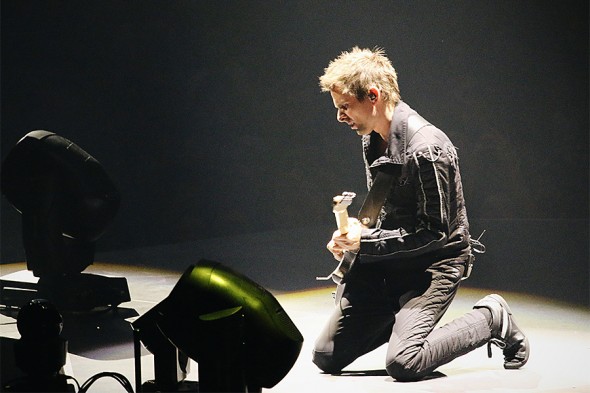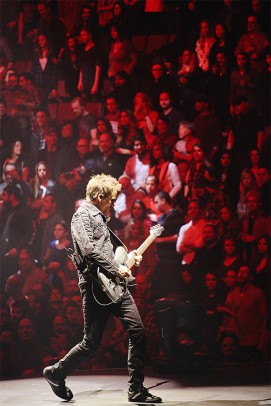Muse puts on extraterrestrial performance

Muse frontman Matthew Bellamy wowed the crowd with his astonishing vocals Jan. 13 at the United Center. Photo: Pearl Shin
One of the biggest concerns fans have when seeing their favorite band in a large venue, especially one as big as the United Center, is the lack of intimacy that prevents them from truly experiencing the magic of the concert.
English rock band Muse, which performed Jan. 13 at the United Center, put a lot of effort into eliminating that feeling of alienation during the group’s Drones World Tour.
The band opened the set with two powerhouse tracks from “Drones,” the group’s latest album: “Psycho” and “Dead Inside.” The album captures the theme of chaos, a fear of artificial intelligence and the idea of combatting oppressive rule. The lyrics and group’s overall look – lead singer and guitarist Matt Bellamy, bassist Chris Wolstenholme and drummer Dom Howard were uniformly clad in head-to-toe black – painted an image of a dystopian future, setting the ambiance for the show.
Muse is known for top-notch theatricality in its stage sets, but nothing compares to the production that went into the Drones Tour stage. With a constantly morphing setup, which included a rotating platform in the middle of the arena and walkways stretching the length of the venue, the band truly outdid itself. The 360-degree stage provided an explosive and interactive concert experience.
It’s ironic that despite the album’s lyrical themes of rejecting technology, the band embraced it for the tour. The use of technology helped create a feeling of closeness and unity by bringing the band and audience together.
With help from cameras that orbited around him, Bellamy reached out to the crowd and made eye contact with each fan, creating a different feel than just showing close-ups of the band on screens.
Creating intimacy wasn’t the only purpose behind the elaborate effects. The projection showed visuals of space, artificial intelligence, missiles and other futuristic imagery, creating a sensory experience that immersed everyone in the spectacle before them. During “The Handler,” for example, giant digital hands wielding silver threads appeared on screens behind Bellamy and Wolstenholme, mimicking the motions of a puppeteer controlling their actions.
Unlike most singers, Bellamy wasn’t one for words; instead, he transferred all of his energy into singing. The band’s setlist included an impressive 21 songs, balanced with gritty, fast tracks like “Hysteria,” “Supermassive Black Hole,” “Time Is Running Out” and “Uprising,” as well as slower tunes like “Apocalypse Please” and “Madness.” Each song was brought to life on stage by Howard’s vigorous drumming, Wolstenholme’s steady bass and, of course, Bellamy’s astonishing vocals.
Bellamy’s passion translated into his powerful performance. At one point, he threw his guitar onto the stage, breaking it. He later posted a picture of the damage on Muse’s official Instagram and Twitter accounts, commenting, “Thanks Chicago!”
During the finale, the signature Muse drone was released, drifting over the audience as the crowd stared in awe. These details transcended Muse’s performance from just a concert to a full-on theatrical masterpiece.
The band concluded the night with an electric performance of “Mercy” and “Knights of Cydonia,” ending the concert in the most exhilarating way.
Though the band did not come back for an encore, the show could not have ended better. In all aspects, it was a truly extraterrestrial experience.
Categories

